Homeostasis
Objective 1.5
1.5.1 Characterize homeostasis.
1.5.2 Provide specific examples of organ systems maintaining homeostasis.
1.5.3 List the components of a homeostatic feedback loop and explain the function of each.
1.5.4 Explain how different organ systems relate to one another to maintain homeostasis.
1.5.5 Give an example of positive and negative feedback loops in homeostasis.
1.5.6 Describe the specific structures included in the feedback loops.
Physiology is mostly the study of homeostasis. Homeostasis is the condition of equilibrium in the body’s internal environment due to the constant interaction of the body’s many regulatory processes.
Break this definition down into its parts and try to understand it fully. What is equilibrium? What is meant by the internal environment? What sort of form will the interaction between regulatory processes take, and what exactly is meant by ” regulatory processes?”
Homeostatic Feedback Loops
We accomplish homeostasis by utilizing feedback loops. Each feedback loop consists of a receptor, a control center, and an effector. The receptor is what perceives the stimulus. The receptor sends that information to the control center. The control center makes the decision (“what do I change to bring this system back into balance?”), then sends a command to the effector to cause that change..
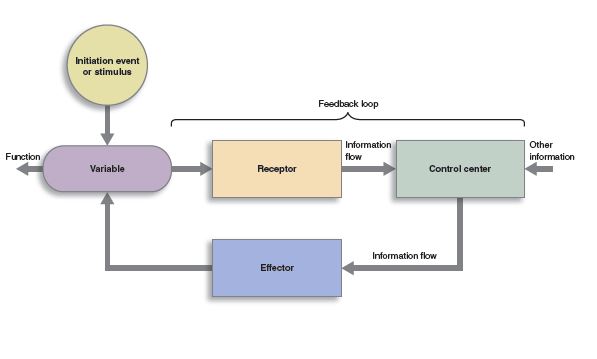
The easiest way to approach the study of homeostasis is to study specific examples, remembering that they reflect general principles that we will re-visit many times.
All body systems must maintain some sort of equilibrium. We thirst, and we drink; we hunger, and we eat. In these (apparently) simple examples, there are many embedded, interacting, and complex feedback loops. What we call “thirst” may be triggered by an imbalance, such as an increase in the sodium concentration of the blood to higher than normal limits. The sodium concentration of the blood is monitored by receptors, a kind of molecular sensor that sends a signal to the control center in the brain. The “thirst center” of the brain, in turn, sends a signal to other areas of the brain that are responsible for driving us to find, and then drink, water. This loop continues operating until homeostasis (in this case normal blood sodium levels) is restored.
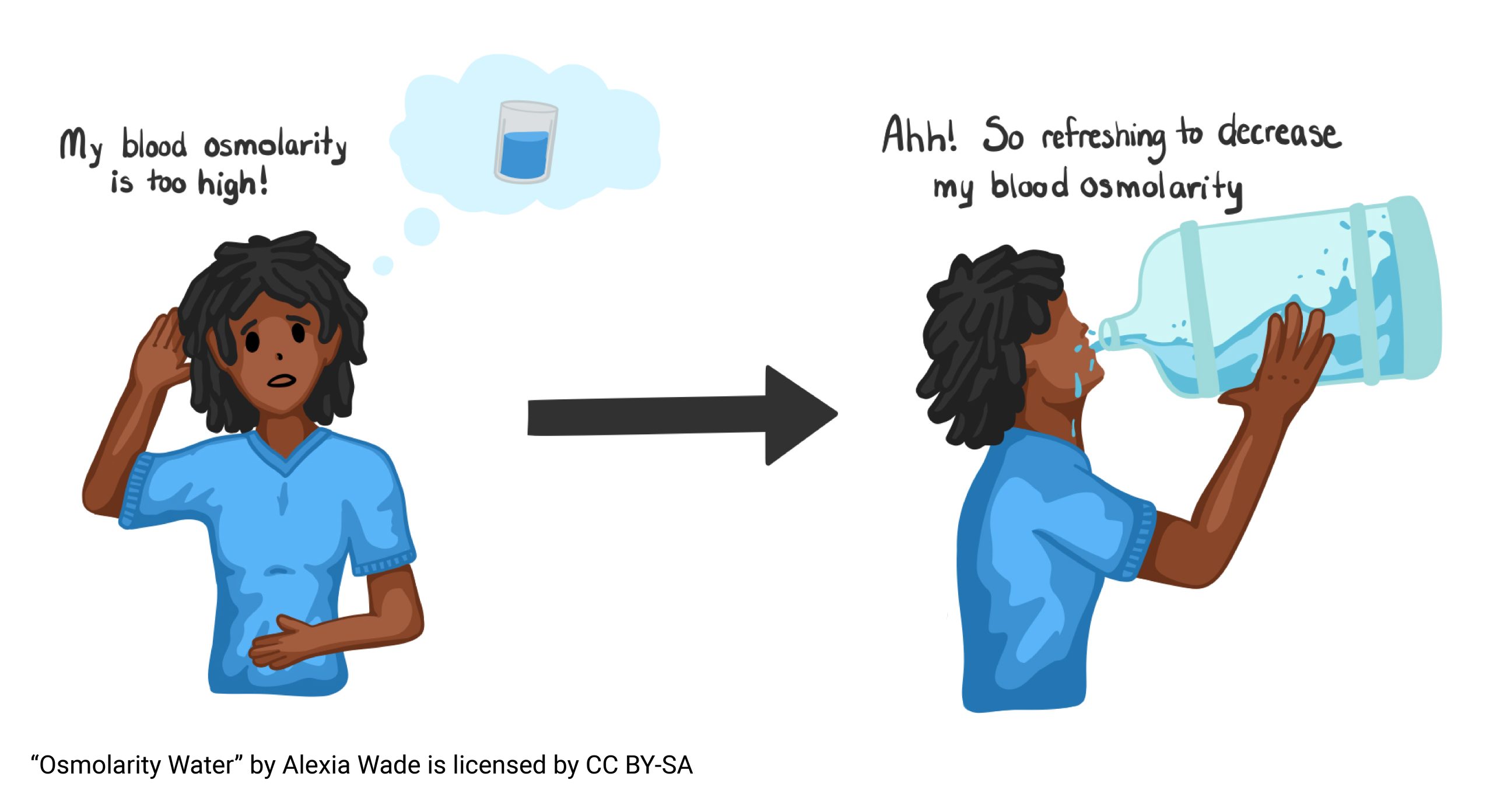
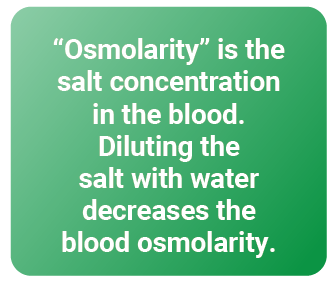
Ahh! So refreshing to decrease my blood osmolarity!
My blood osmolarity is too high!
“Osmolarity” is the salt concentration in the blood. Diluting the salt with water decreases the blood osmolarity.
- Variable: Change in blood osmolarity
- Receptor: Senses change in blood osmolarity
- Control center: Determines blood osmolarity is higher than the setpoint, and makes the decision to lower it by drinking water
- Effector: Thirst response
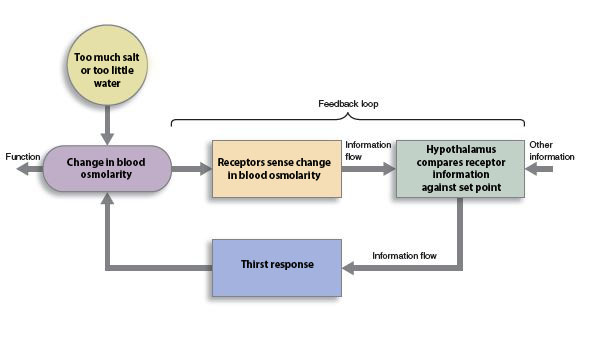
You should be familiar with examples of receptors, control centers, and effectors for many different homeostatic loops. We will study a few now, and add many more as the course progresses.
All feedback loops in the human body can be classified as either negative feedback loops or positive feedback loops. If the response reverses the stimulus, a system is operating by negative feedback.
Homeostasis: Negative Feedback Loops
Negative feedback loops are by far the most common kind of homeostatic circuit. This is because they are self-controlling; they cannot spin out of control if they are over-stimulated.
For example, imagine you are outside on a cold day and your body temperature begins to lower. You have receptors that sense that decrease in body temperature. That signal is sent to the temperature regulatory center in the brain. In an effort to increase body temperature the control center will send a signal to cause muscles to shiver and blood vessels to constrict, to increase heat production and conservation. Thus, increasing body temperature and reversing the initial stimulus (decreased body temperature).
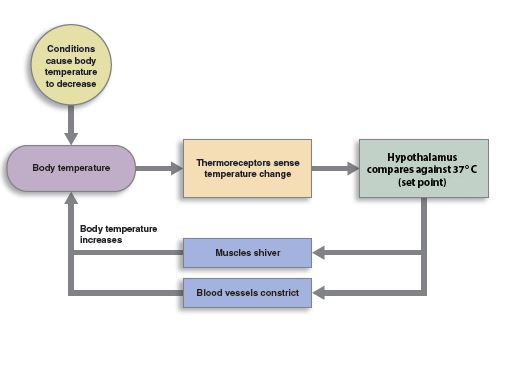
- Variable: Body temperature
- Receptor: A thermoreceptor senses the change in body temperature
- Control center: The hypothalamus determines the body temperature is lower than the setpoint (37°C), and makes the decision to raise it by activating shivering and blood vessel constriction
- Effector: Muscles shiver; blood vessels constrict (shrink)
The opposite effect happens if the temperature increases. You will respond to the increase in temperature by
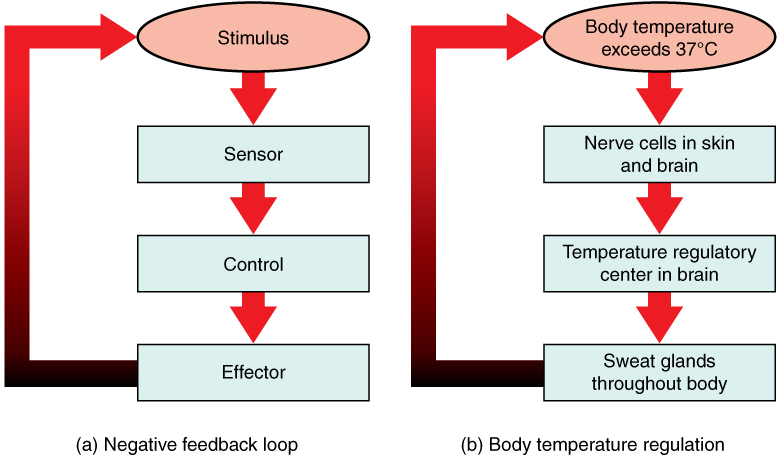
- Variable: Body temperature
- Receptor: A thermoreceptor senses the change in body temperature
- Control center: The hypothalamus determines the body temperature is higher than the setpoint (37°C), and makes the decision to lower it by activating sweating and blood vessel dilation
- Effector: Sweat glands secrete sweat; blood vessels dilate (enlarge)
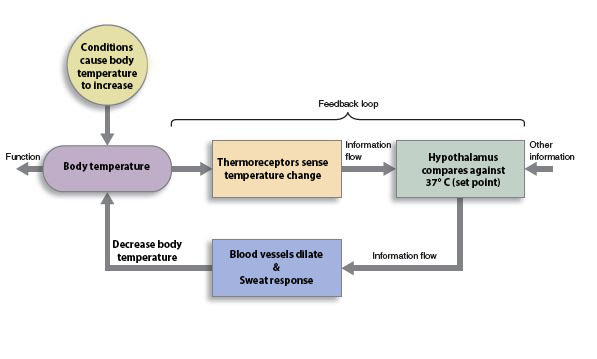 Another familiar example is blood sugar (glucose) control. Something happens to increase your blood glucose (e.g. you eat a bowl of Cap’n Crunch). Receptors in the beta cells of the pancreas detect the increase in blood glucose. The beta cells (also a control center) release insulin. Insulin increases glucose uptake into cells. As glucose is moved out of the blood and into cells the blood glucose levels are lowered.
Another familiar example is blood sugar (glucose) control. Something happens to increase your blood glucose (e.g. you eat a bowl of Cap’n Crunch). Receptors in the beta cells of the pancreas detect the increase in blood glucose. The beta cells (also a control center) release insulin. Insulin increases glucose uptake into cells. As glucose is moved out of the blood and into cells the blood glucose levels are lowered.
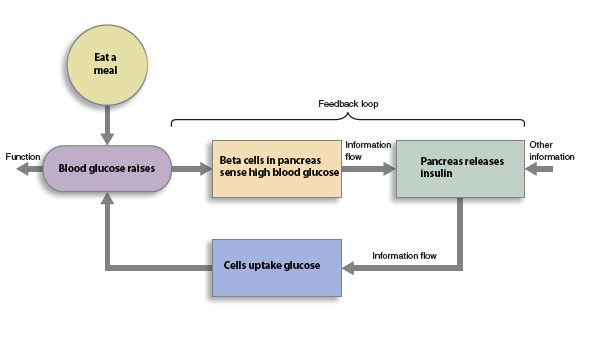
- Variable: Blood sugar level (blood glucose) is raised by absorption of digested Cap’n Crunch from the intestines
- Receptor: Beta cells in pancreas sense high glucose
- Control center: Pancreas determines blood glucose is above setpoint and releases a chemical signal (the hormone insulin) into the bloodstream
- Effector: Insulin binds to receptors on the surface of body cells. The cells receiving the signal increase their glucose uptake
Homeostasis: Positive Feedback Loops
If the response enhances or intensifies the stimulus, a system is operating by positive feedback.
Only rarely are positive feedback loops used in the human body. They cannot be controlled as they move forward; rather, they only shut down when the system is depleted or the problem is corrected. Still, when your body needs a strong, rapid and ongoing response, such as in blood clotting or childbirth, a positive feedback loop is the best choice.
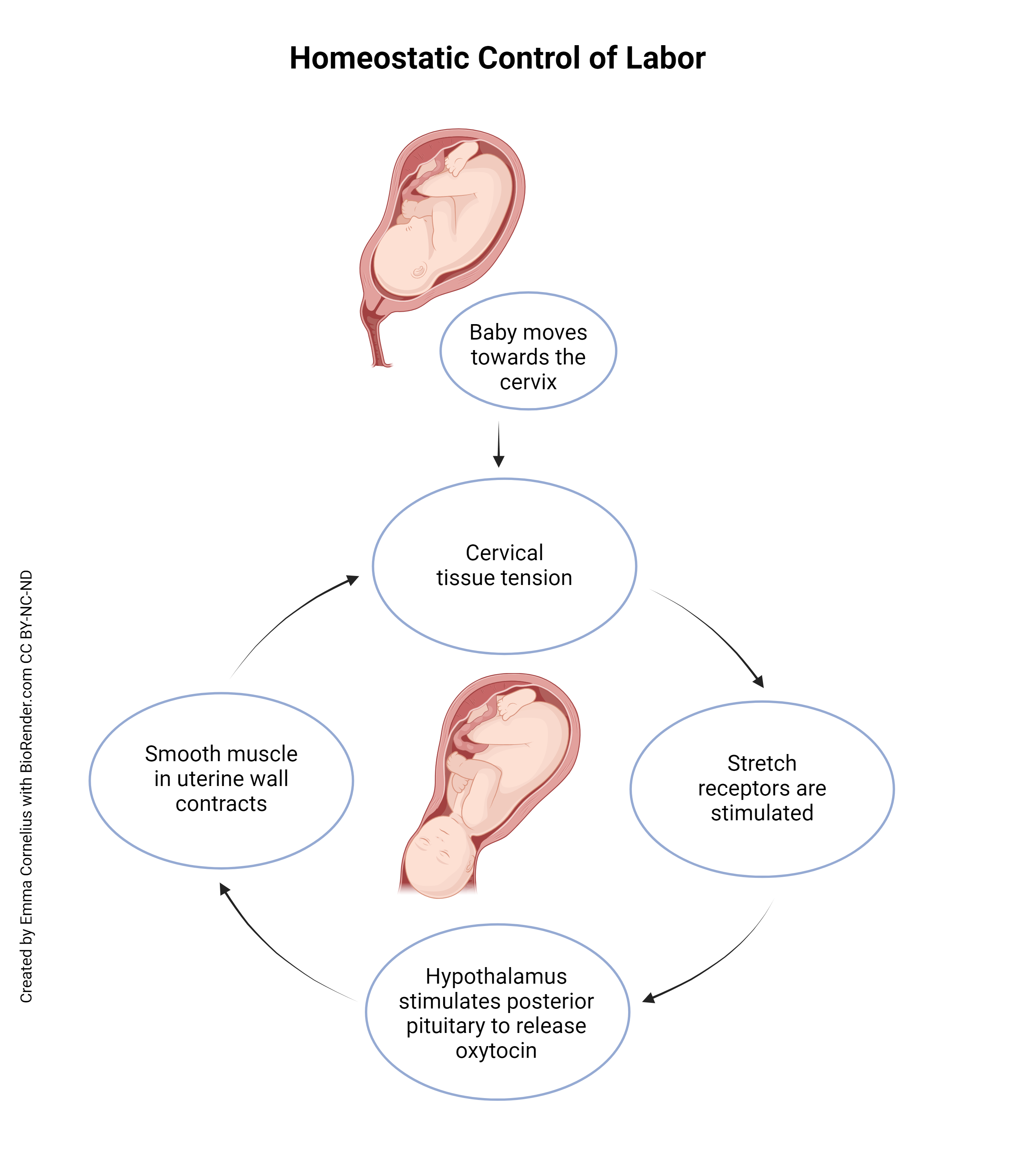
When the baby is forced into the cervix, the cervix stretches, and the signal is sent to the brain. The brain releases oxytocin, a hormone that travels through the bloodstream to increase contractions in the uterus. These contractions force the baby further into the birth canal, which stretches the cervix even more, and the cycle continues, increasing in intensity and frequency, until the baby is born.
- Variable: Diameter of cervix
- Receptor: Stretch receptors sense stretch in the ring of muscle around the cervix
- Control center: The hypothalamus responds to cervical stretch by releasing a chemical signal (the hormone oxytocin) from the posterior pituitary gland into the bloodstream
- Effector: Smooth muscle in the uterine wall contracts more forcefully, pushing the baby further into the cervix
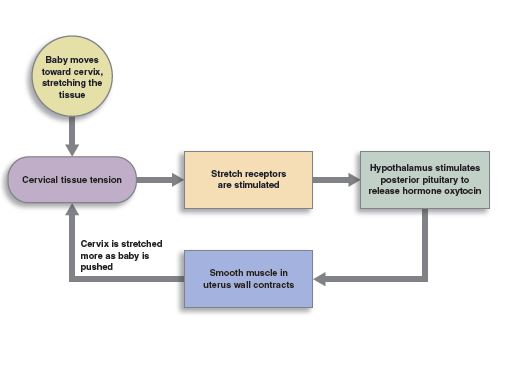
The suckling response is also a positive feedback loop. Baby suckles mother’s nipple. Receptors detect the tug from the baby and relay that information to the control center. The control center in the hypothalamus interprets the signal and releases a hormone (oxytocin — yes the same one) which ejects milk from milk glands in the breast. The baby responds to milk by tugging more. This positive loop only stops when baby is sated.
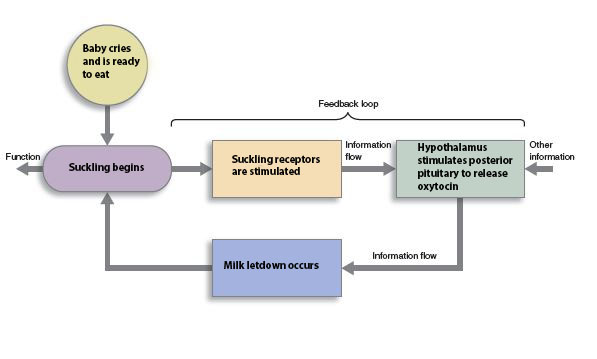
- Variable: Milk release
- Receptor: Touch receptors in the mother’s nipple sense the touch of baby’s lips
- Control center: The hypothalamus responds to the baby’s lips touching the mother’s nipple by releasing a chemical signal (again, the hormone oxytocin) from the posterior pituitary gland into the bloodstream
- Effector: Smooth muscle in the milk ducts relax, releasing the gland contents (breast milk) so the baby can drink
A third example of a positive feedback loop is blood clotting. Blood leaking from an injured vessel causes platelets to rub each other. Receptors on the surface of platelets detect this friction and the platelets become activated. Activated platelets set a cascade into motion which results in the formation of a sticky protein (fibrin) which rubs platelets together more. This only stops when the blood (locally) runs out of fibrin.

- Variable: Platelet “stickiness”
- Receptor: Platelets bang into each other as they are forced out of blood vessels
- Control center: Platelets release a chemical signal which makes nearby platelets “stickier”
- Effector: Platelets stick together and form platelet plug
The last positive feedback loop example we’ll cover here is severe blood loss. A final positive feedback loop example (for our current discussion) is severe blood loss. This example is a bit more complex. Significant blood loss results in a decrease in blood pressure. Blood pressure is a regulated variable. Receptors in the major vessels leading away from the heart detect a decrease in pressure. The control centers in the brainstem and spinal cord direct the heart to beat more quickly in an attempt to increase the amount of blood in the circuit. This places increased metabolic demands on the heart which can only be met by more blood but the blood is on the floor of the Emergency Department and not available to the heart. Tissues also undergo hypoxia (low oxygen available) which leads to vasodilation (in an attempt to bring in more blood) but this vasodilation leads to more blood loss. Heart damage decreases heart efficiency and less blood is pumped, reducing blood pressure…and the positive feedback loop continues until death occurs.
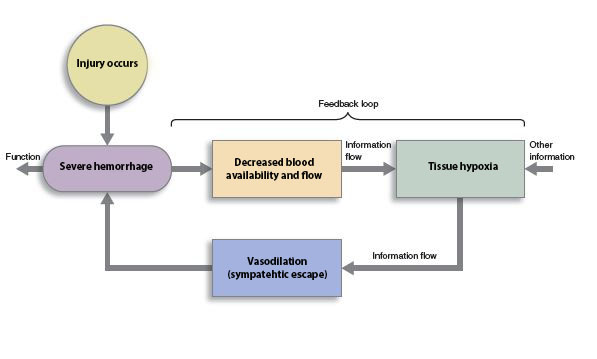
Because events controlled by positive feedback are more difficult to control and are more complex, they are not used very often. The only thing that stops them is some outside mechanism: the elements needed to clot blood are depleted; the child is born; the child stops suckling or milk is depleted; severe blood loss is halted.
Negative feedback loops are much more common and are used for all sorts of “housekeeping” functions. Negative feedback loops are self-regulating: there is some pre-existing set-point (normal body temperature, normal blood glucose, etc.) and when the system returns to that normal range, the feedback loop is shut down without further intervention.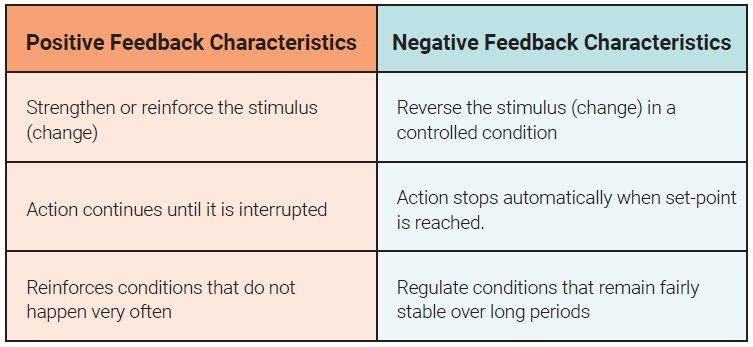
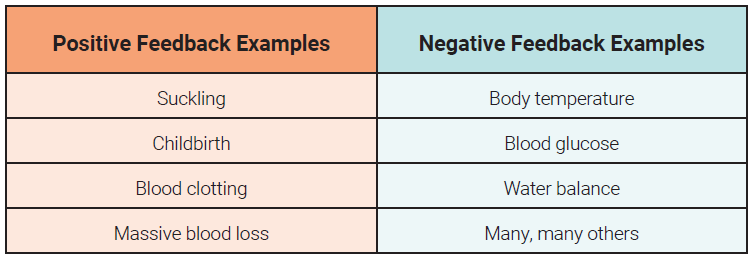
Media Attributions
- U01-041 Homeostasis and Feedback Loops © Open Learning Initiative is licensed under a CC BY-NC-SA (Attribution NonCommercial ShareAlike) license
- U01-042 thirst explainer © Wade, Alexia is licensed under a CC BY-SA (Attribution ShareAlike) license
- U01-043 osmolarity explained graphic © Bizell, Lizz is licensed under a CC BY-SA (Attribution ShareAlike) license
- U01-044 Thirst Feedback Loop © Open Learning Initiative adapted by Justin Burr is licensed under a CC BY-NC-SA (Attribution NonCommercial ShareAlike) license
- U01-045 Low Temp Feedback Loop © Open Learning Initiative adapted by Justin Burr is licensed under a CC BY-NC-SA (Attribution NonCommercial ShareAlike) license
- U01-046 High Temp Negative Feedback Loop © Betts, J. Gordon; Young, Kelly A.; Wise, James A.; Johnson, Eddie; Poe, Brandon; Kruse, Dean H. Korol, Oksana; Johnson, Jody E.; Womble, Mark & DeSaix, Peter is licensed under a CC BY (Attribution) license
- U01-047 high body temp feedback loop © Open Learning Initiative adapted by Justin Burr is licensed under a CC BY-NC-SA (Attribution NonCommercial ShareAlike) license
- U01-048 High Glucose Homeostasis and Feedback Loops © Open Learning Initiative adapted by Justin Burr is licensed under a CC BY-NC-SA (Attribution NonCommercial ShareAlike) license
- U01-049 Homeostatic control of labor 2706px © Cornelius, Emma is licensed under a CC BY-NC-ND (Attribution NonCommercial NoDerivatives) license
- U01-050 feedback_birth © Open Learning Initiative adapted by Justin Burr is licensed under a CC BY-NC-SA (Attribution NonCommercial ShareAlike) license
- U01-051 Suckling Feedback Loop © Open Learning Initiative adapted by Justin Burr is licensed under a CC BY-NC-SA (Attribution NonCommercial ShareAlike) license
- U01-052 Blood ClottingFeedback Loop © Open Learning Initiative adapted by Justin Burr is licensed under a CC BY-NC-SA (Attribution NonCommercial ShareAlike) license
- U01-053 Severe Hemorrhage Feedback Loop © Open Learning Initiative adapted by Justin Burr is licensed under a CC BY-NC-SA (Attribution NonCommercial ShareAlike) license
- U01-054 positive vs negative feedback characteristics table © Bizell, Lizz is licensed under a CC BY-SA (Attribution ShareAlike) license
- U01-055 positive vs negative feedback examples table © Bizell, Lizz is licensed under a CC BY-SA (Attribution ShareAlike) license

